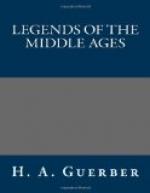[Sidenote: The Roman de Troie.] The “Roman de Troie” was quite as popular in mediaeval Europe as the “Iliad” had been in Hellenic countries during the palmy days of Greece, and was translated into every dialect. There are still extant many versions of the romance in every European tongue, for it penetrated even into the frozen regions of Scandinavia and Iceland. It was therefore recited in every castle and town by the wandering minstrels, trouveres, troubadours, minnesingers, and scalds, who thus individually and collectively continued the work begun so many years before by the Greek rhapsodists. Thus for more than two thousand years the story which still delights us has been familiar among high and low, and has served to beguile the hours for old and young.
This cycle further includes a revised and much-transformed edition of the adventures of Aeneas and of the early history of Rome. But although all these tales were first embodied in metrical romances, these soon gave way to prose versions of equally interminable length, which each relator varied and embellished according to his taste and skill.
The extreme popularity of Benoit de Sainte-More’s work induced many imitations, and the numerous chansons de gestes, constructed on the same general plan, soon became current everywhere. Sundry episodes of these tales, having been particularly liked, were worked over, added to, and elaborated, until they assumed the proportions of romances in themselves. Such was, for example, the case with the story of Troilus and Cressida, which was treated by countless mediaeval poets, and finally given the form in which we know it best, first by Chaucer in his “Canterbury Tales,” and lastly by Shakespeare in his well-known play.
[Sidenote: Alexandre le Grant.] Another great romance of the classical cycle is the one known as “Alexandre le Grant.” First written in verse by Lambert le Cort, in a meter which is now exclusively known as Alexandrine, because it was first used to set forth the charms and describe the deeds of this hero, it was recast by many poets, and finally turned into a prose romance also.
The first poetical version was probably composed in the eleventh century, and is said to have been twenty-two thousand six hundred lines long. Drawn from many sources,—for the Greek and Latin writers had been all more or less occupied with describing the career of the youthful conqueror and the marvels he discovered in the far East,—the mediaeval writers still further added to this heterogeneous material.
The romance of “Alexandre le Grant,” therefore, purports to relate the life and adventures of the King of Macedon; but as Lambert le Cort and his numerous predecessors and successors were rather inclined to draw on imagination, the result is a very extravagant tale.




